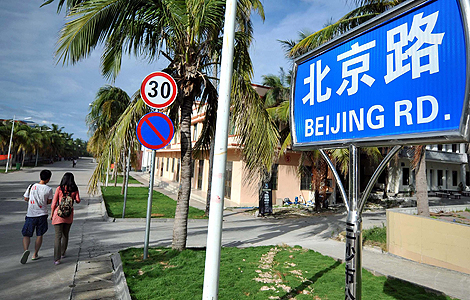'Positive' sign on free trade pact
Updated: 2013-07-03 01:12
By DING QINGFEN in Beijing and JOSEPH BORIS in New York (China Daily)
|
||||||||
China is becoming 'positive' toward the US-led Asia- Pacific free trade agreement, saying it may join the Trans-Pacific Partnership, although it will take time to do so, according to sources at the Ministry of Commerce.
'China is still doing its research (on the TPP),' said a source close to the issue.
Consensus has been reached on the importance of the free trade pact, a step forward from some time ago, when many people were opposed to the proposal, an official told China Daily on condition of anonymity.
The US launched the TPP in 2010 in an attempt to strengthen trade relations with the Asia-Pacific region, and in April participating countries approved Japan joining the TPP talks. Eleven nations are involved, including Canada, Peru, Chile, Vietnam and New Zealand.
The Obama administration hopes to conclude talks on the proposed pact by the end of the year, but many trade experts expect them to stretch into 2014.
With Japan, the world's third-largest economy, on board, the final TPP pact will cover nearly 40 percent of global economic output and one-third of trade worldwide.
Experts said the US sees the TPP as part of its economic rebalancing toward Asia, and also as a response to the growing power of China in Asia and the world. China has repeatedly said it will follow and observe the progress of the TPP, without making its position clear.
But with some government officials recently saying they are willing to research the TPP, China's attitude seems to be changing.
Tian Deyou, deputy director-general of the Department of American and Oceanian Affairs with the Ministry of Commerce, agreed. The Chinese government realizes it's time to change its mind on the matter, he said.
In May, the US Under Secretary of Commerce for International Trade, Francisco J. Sanchez, said the United States would welcome China joining the TPP.
In response, Shen Danyang, a spokesman for the Ministry of Commerce, said China will analyze the possibilities of joining the pact, and assess the pros and cons based on research and the principles of equality and mutual benefit.
Hong Lei, a spokesman for the Ministry of Foreign Affairs, said China is open to all trade pacts that boost the integration and prosperity of the regional economy in Asia, including the TPP.
But there is a long way to go before China could eventually join, as the pact would involve the core interests of many sectors including finance, foreign exchange and State-owned enterprises, Tian said.
Arvind Subramanian, who researches trade issues at the Center for Global Development and the conservative Peterson Institute for International Economics in Washington, said: 'It's not clear to me that the US wants China in the TPP, at least during the negotiating phase, if the whole premise of this is asymmetric globalization. If China is in on the negotiations, they could sink because China's too big.'
With the Doha round of talks under the framework of the World Trade Organization, which were launched more than 10 years ago, stalled, countries worldwide are pursuing new market openings through bilateral and regional trade pacts.
The objective of the Doha round is to lower trade barriers around the world.
Tian said the Doha stalemate has spurred the US to scramble for regional preferential trade pacts outside the WTO.
Besides the TPP, the US has announced the launch of talks on the Transatlantic Trade and Investment Partnership with the 28-nation European Union, with the first round of negotiations due in early July. The two sides already have bilateral trade and investment worth nearly $5 trillion, the world's largest.
US Vice-President Joe Biden has said the US expects to reshape global rules for trade and improve the rules and norms by advancing the proposed Asia-Pacific regional free trade agreement and another agreement with the EU.
Against such a background, the unnamed source said: 'China has to reconsider its strategy, turning more positive about the TPP. Otherwise, it will get sidelined on the global trade rules.'
Xue Rongjiu, vice-chairman of the China Society for WTO Studies, said: 'High levels of the Chinese government should show their resolution on joining the TPP, pressurizing ministries and local governments to make it happen. We have to break the barriers and break the vested interests.'
Wu Jiahuang, another vice-chairman of the China Society for WTO Studies, said while China's new leadership is seeking further reform and opening-up, the TPP could be a breakthrough for the nation.
'The earlier we join, the more benefits we will enjoy.'
Matthew Goodman, who was White House coordinator for the Asia-Pacific Economic Cooperation and the East Asia Summit forums during US President Barack Obama's first term, said: 'In a practical sense, it would be very difficult to incorporate China into the (TPP) negotiations at this stage. I don't think China, even if it expresses interest and seriously considers it, is going to be ready, willing and able to join.'
US Trade Representative Demetrios Marantis said in an interview with CNBC that while the TPP seeks to eliminate trade barriers and require members to comply with a high standard of transparency, China has to meet the high standards if it wants to join the pact.
The unnamed source from the Ministry of Commerce said: 'We know it's difficult, but the key point is we have to change minds and stick to opening-up to the world. Once we are determined on the TPP, everything else will be solved.'
The source said ongoing talks on an investment treaty between China and the US will pave the way for China to join the TPP.
'The treaty touches on many sensitive and important issues, based on which talks on the TPP would be easier,' he said.
China and the US began to negotiate on the investment treaty early in 1980, but the talks were suspended before being relaunched in 2008.
Yang Ziman in Beijing and Chen Weihua in Washington contributed to this story.

 China's youngest city glistens under palm trees
China's youngest city glistens under palm trees
 Xinjiang tourism recovering
Xinjiang tourism recovering
 Quebec disaster death toll jumps to 13
Quebec disaster death toll jumps to 13
 Mourn for students in San Francisco air crash
Mourn for students in San Francisco air crash
 Rolling stone finally settles
Rolling stone finally settles
 Double-decker bus caught fire in Shanghai
Double-decker bus caught fire in Shanghai
 China, Russia begin live-fire navy drill
China, Russia begin live-fire navy drill
 Grape expectations for Xinjiang county
Grape expectations for Xinjiang county
Most Viewed
Editor's Picks

|

|

|

|

|

|
Today's Top News
Laden's life on the run revealed
US mulls hastening withdrawal from Afghanistan
China's inflation grows 2.7% in June
Country singer Randy Travis in critical condition
Police look for suspects in Brazil soccer slaying
Nuclear power pricing system launched
Air crash victims' parents leave for US
Terror law called for after attack
US Weekly

|

|






